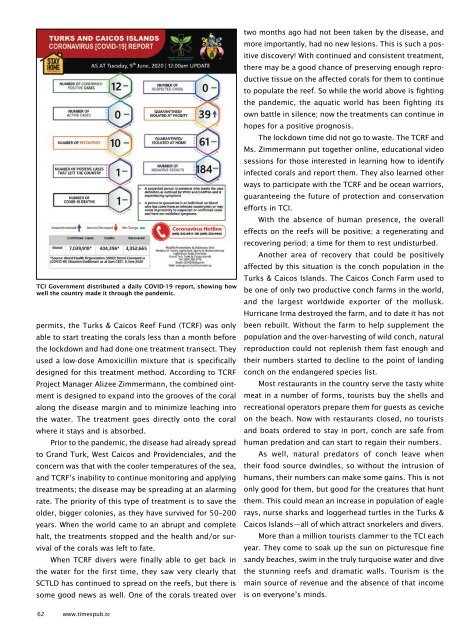Times of the Islands Summer 2020
Presents the "soul of the Turks & Caicos Islands" with in-depth features about local people, culture, history, environment, businesses, resorts, restaurants and activities.
Presents the "soul of the Turks & Caicos Islands" with in-depth features about local people, culture, history, environment, businesses, resorts, restaurants and activities.
Create successful ePaper yourself
Turn your PDF publications into a flip-book with our unique Google optimized e-Paper software.
TCI Government distributed a daily COVID-19 report, showing how<br />
well <strong>the</strong> country made it through <strong>the</strong> pandemic.<br />
permits, <strong>the</strong> Turks & Caicos Reef Fund (TCRF) was only<br />
able to start treating <strong>the</strong> corals less than a month before<br />
<strong>the</strong> lockdown and had done one treatment transect. They<br />
used a low-dose Amoxicillin mixture that is specifically<br />
designed for this treatment method. According to TCRF<br />
Project Manager Alizee Zimmermann, <strong>the</strong> combined ointment<br />
is designed to expand into <strong>the</strong> grooves <strong>of</strong> <strong>the</strong> coral<br />
along <strong>the</strong> disease margin and to minimize leaching into<br />
<strong>the</strong> water. The treatment goes directly onto <strong>the</strong> coral<br />
where it stays and is absorbed.<br />
Prior to <strong>the</strong> pandemic, <strong>the</strong> disease had already spread<br />
to Grand Turk, West Caicos and Providenciales, and <strong>the</strong><br />
concern was that with <strong>the</strong> cooler temperatures <strong>of</strong> <strong>the</strong> sea,<br />
and TCRF’s inability to continue monitoring and applying<br />
treatments; <strong>the</strong> disease may be spreading at an alarming<br />
rate. The priority <strong>of</strong> this type <strong>of</strong> treatment is to save <strong>the</strong><br />
older, bigger colonies, as <strong>the</strong>y have survived for 50–200<br />
years. When <strong>the</strong> world came to an abrupt and complete<br />
halt, <strong>the</strong> treatments stopped and <strong>the</strong> health and/or survival<br />
<strong>of</strong> <strong>the</strong> corals was left to fate.<br />
When TCRF divers were finally able to get back in<br />
<strong>the</strong> water for <strong>the</strong> first time, <strong>the</strong>y saw very clearly that<br />
SCTLD has continued to spread on <strong>the</strong> reefs, but <strong>the</strong>re is<br />
some good news as well. One <strong>of</strong> <strong>the</strong> corals treated over<br />
two months ago had not been taken by <strong>the</strong> disease, and<br />
more importantly, had no new lesions. This is such a positive<br />
discovery! With continued and consistent treatment,<br />
<strong>the</strong>re may be a good chance <strong>of</strong> preserving enough reproductive<br />
tissue on <strong>the</strong> affected corals for <strong>the</strong>m to continue<br />
to populate <strong>the</strong> reef. So while <strong>the</strong> world above is fighting<br />
<strong>the</strong> pandemic, <strong>the</strong> aquatic world has been fighting its<br />
own battle in silence; now <strong>the</strong> treatments can continue in<br />
hopes for a positive prognosis.<br />
The lockdown time did not go to waste. The TCRF and<br />
Ms. Zimmermann put toge<strong>the</strong>r online, educational video<br />
sessions for those interested in learning how to identify<br />
infected corals and report <strong>the</strong>m. They also learned o<strong>the</strong>r<br />
ways to participate with <strong>the</strong> TCRF and be ocean warriors,<br />
guaranteeing <strong>the</strong> future <strong>of</strong> protection and conservation<br />
efforts in TCI.<br />
With <strong>the</strong> absence <strong>of</strong> human presence, <strong>the</strong> overall<br />
effects on <strong>the</strong> reefs will be positive; a regenerating and<br />
recovering period; a time for <strong>the</strong>m to rest undisturbed.<br />
Ano<strong>the</strong>r area <strong>of</strong> recovery that could be positively<br />
affected by this situation is <strong>the</strong> conch population in <strong>the</strong><br />
Turks & Caicos <strong>Islands</strong>. The Caicos Conch Farm used to<br />
be one <strong>of</strong> only two productive conch farms in <strong>the</strong> world,<br />
and <strong>the</strong> largest worldwide exporter <strong>of</strong> <strong>the</strong> mollusk.<br />
Hurricane Irma destroyed <strong>the</strong> farm, and to date it has not<br />
been rebuilt. Without <strong>the</strong> farm to help supplement <strong>the</strong><br />
population and <strong>the</strong> over-harvesting <strong>of</strong> wild conch, natural<br />
reproduction could not replenish <strong>the</strong>m fast enough and<br />
<strong>the</strong>ir numbers started to decline to <strong>the</strong> point <strong>of</strong> landing<br />
conch on <strong>the</strong> endangered species list.<br />
Most restaurants in <strong>the</strong> country serve <strong>the</strong> tasty white<br />
meat in a number <strong>of</strong> forms, tourists buy <strong>the</strong> shells and<br />
recreational operators prepare <strong>the</strong>m for guests as ceviche<br />
on <strong>the</strong> beach. Now with restaurants closed, no tourists<br />
and boats ordered to stay in port, conch are safe from<br />
human predation and can start to regain <strong>the</strong>ir numbers.<br />
As well, natural predators <strong>of</strong> conch leave when<br />
<strong>the</strong>ir food source dwindles, so without <strong>the</strong> intrusion <strong>of</strong><br />
humans, <strong>the</strong>ir numbers can make some gains. This is not<br />
only good for <strong>the</strong>m, but good for <strong>the</strong> creatures that hunt<br />
<strong>the</strong>m. This could mean an increase in population <strong>of</strong> eagle<br />
rays, nurse sharks and loggerhead turtles in <strong>the</strong> Turks &<br />
Caicos <strong>Islands</strong>—all <strong>of</strong> which attract snorkelers and divers.<br />
More than a million tourists clammer to <strong>the</strong> TCI each<br />
year. They come to soak up <strong>the</strong> sun on picturesque fine<br />
sandy beaches, swim in <strong>the</strong> truly turquoise water and dive<br />
<strong>the</strong> stunning reefs and dramatic walls. Tourism is <strong>the</strong><br />
main source <strong>of</strong> revenue and <strong>the</strong> absence <strong>of</strong> that income<br />
is on everyone’s minds.<br />
62 www.timespub.tc

















